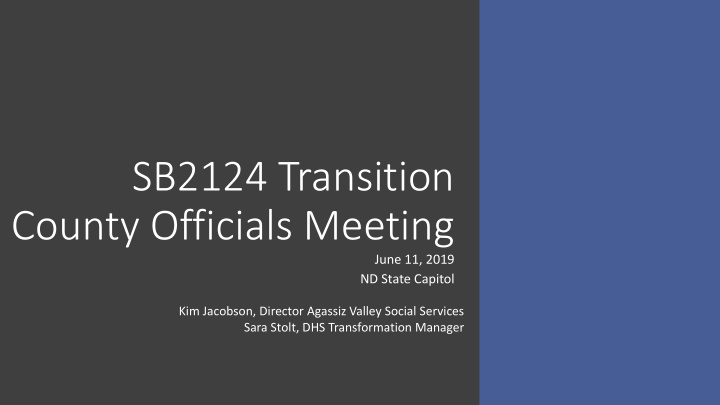



SB2124 Transition County Officials Meeting June 11, 2019 ND State Capitol Kim Jacobson, Director Agassiz Valley Social Services Sara Stolt, DHS Transformation Manager
Improving programs is more than looking at structure: process and cultural change must accompany structural change ▪ 3 Core Areas 3 Key Levers for Change – Process – Structure – Culture ▪ Focus is on service delivery to the client in the most Structure effective and efficient way possible ▪ Seek to remove geographic, political and cultural Process boundaries to deliver smart, efficient and compassionate human services ▪ Primary Stakeholders Culture – Individuals & Families – Taxpayers – Employees 2
Zones + Pilots: Working Together Zones: Structure Pilots: Culture, Process + Structure Eliminate county boundaries and geographically Build processes around no county boundaries or defined service areas geographically defined service areas Flexible to support each programs structure Reinforces a state caseload vs. a county caseload Eliminates complicated layers of hierarchy and Identifies the right structure for a program based on approval the new process Increases funding for program and decreases Builds processes with decision making at the lowest administration possible level where appropriate Zones will collaborate with each other based on Builds quality at the source unique needs of the communities they serve Improves workflow and timeliness Zones will allow for subject matter experts as Creates team ownership of the process supervisors Identifies efficiencies in programs that allow us to Specialty units will be developed in some zones to shift more resources to other programs in need provide services based on community need
Establish Your Goal: What does your system do? Set Ambitious Targets Process Identify Constraints to Achieving the Goal and Targets Improvement Method Build The Ideal System Map Leverage Your Constraints Manage Your Work in Progress and Adjust
Emphasis on collaboration and sharing resources Elimination of county boundaries for both the people served and for those providing the service Establish ambitious goals and metrics / track goals and Key Pilot metrics Features Identify the core problem and provide the right solution to the problem to achieve the goal and targets Adjust and update the process as needed Focus on structure, process and culture
CPS PILOT COUNTY FOCUS
CPS Pilot Goal 1: Conduct the face to face with the child within 3 days of case assignment. 90% 80% 70% 60% 50% 40% 30% 20% 10% 0% September 17-October 16 October 17-November 16 September 17-December 16
12 Months of CPS Assessments TIMELIN ESS SFY 2018 Row Labels Average of Compliance25 Average of Compliance45 Average of Compliance62 Average of Compliance121 Pilot 7.35% 22.65% 40.88% 83.97% Badlands 7.99% 17.84% 32.34% 74.91% Southeast 7.14% 24.22% 43.69% 86.94% N on-Pilot 12.85% 30.51% 51.09% 89.81% Lake Region 9.86% 33.97% 53.97% 91.78% North Central 13.65% 32.11% 46.92% 85.64% Northeast 6.16% 22.00% 47.96% 90.21% Northwest 11.16% 30.93% 50.14% 90.11% South Central 22.62% 50.45% 78.10% 94.79% West Central 14.17% 26.13% 45.92% 90.20% Grand Total 11.22% 28.19% 48.07% 88.08%
Goal 2: Complete 50% of cases in 25 days, 75% in 45 days and 95% in 62 days. 100% 90% 80% 70% 60% 50% 40% 30% 20% 10% 0% Baseline: Previous 12 Months September 17-December 16 25 Days 45 Days 62 Days
Worked a total of 805 cases during September 17-December 16. Some of these cases were already started when the pilot started on September 17, 2018.* CPS Pilot Data 17% of the 805 cases have exceeded 62 days thus far. The baseline for 12 months of CPS cases in the pilot region was 59.2% exceeded the law of 62 days.
Collaboration among all counties Central intake – working as one intake team CPS supervisor ratio of 1:6 CPS Pilot Features More robust supervision and case staffing with CPS workers Standard safety plan Detailed timelines that are tracked daily
CPS REDESIGN EXPANSION COUNTY FOCUS
CHILDCARE LICENSING PILOT COUNTY/STATE FOCUS
Revised licensing checklist from 13 pages to 4 Same checklist to be used for new licenses, unannounced and renewals Features Rebuilt the new licensing process to be provider driven Propose a new structure that shifts the regional rep the Early Childhood Supervisor in zones Launch pilot July 1
LTC PILOT COUNTY FOCUS
State employment – transferring up to 16 FTEs from county eligibility workers Focus on timeliness + building full applications from the beginning Specialized Eligibility Clear instructions and checklists for applicants Team Central # for questions and technical assistance Launch by September 1, 2019 with a statewide rollout.
IN HOME PILOT COUNTY FOCUS
Launch Date: Summer 2019 Synchronize changes with CPS Redesign Focus on sustaining safety and reducing foster Planning placements Phase Built on a 90-day intense model with the family Build process and policy to support new structure Partnering with Casey Family Programs and other CFS programs to identify a sustainable practice model
Develop remaining 2019 pilot schedule to include foster care, TANF and other identified priority programs Solidify CPS expansion and roll out to remaining counties Next Steps Identify Childcare Licensing transition Continue applying TOC to internal DHS programs (Provider Enrollment, CBCU, Eligibility QC)
Questions
Recommend
More recommend